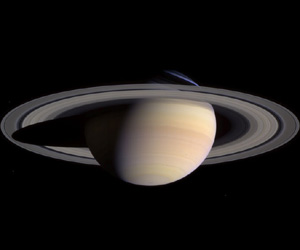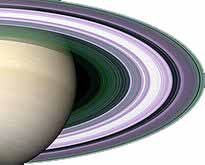|
Planet Saturn
|
The Ringed Planet
 A spectacular image of Saturn captured by NASA's Cassini spacecraft in 2004
A spectacular image of Saturn captured by NASA's Cassini spacecraft in 2004
Close up of Saturn's rings
 Natural color image of Saturn's rings
Natural color image of Saturn's rings
Planet Saturn Facts
- Saturn is the sixth planet from the sun and the second largest in the solar system.
- It is a giant ball of gas composed mainly of hydrogen and helium with no solid surface.
- Saturn is around 10 times bigger than Earth with a diameter of 74,900 miles (120,540 km).
- It orbits the sun at an average distance of 886 million miles (1.4 billion km).
- Saturn has seven main seperate rings around it which are made from rock and ice particles.
- Its main rings extend outwards for over 200,000 km, yet the thickness of the rings range from around only 5 to 15 metres.
- It is believed Saturn's rings will eventually disperse or be drawn into the planet.
- Winds in Saturn's upper atmosphere can reach over 1,000 miles (1,600 km) per hour.
- Saturn has the lowest density of any planet in the solar system, so much so that it would float in water.
Orbit, Atmosphere & Temperature
 Saturn's banded atmosphere
Saturn's banded atmosphere
Orbit
Saturn takes almost 30 years to make one complete orbit of the sun and rotates on its own axis every 10 hours 39 minutes compared to 24 hours on Earth, only Jupiter rotates faster.
Atmosphere
Saturn's atmosphere is composed of 96.3% hydrogen and 3.25% helium. The remaining half percent is made up of trace elements of
ammonia, acetylene, ethane, phosphine and methane.
Temperature
The temperature at the top of Saturn's clouds average around -175C (-285F). The temperature below the clouds gets considerably hotter.
Saturn's core has a temperature of around 11,700C (21,000F).
| Moons & Origin of Name |
| Life on Saturn |
Saturn has many satellites 25 of which have a diameter of at least 6 miles (10
km), the most interesting of these are
Titan and
Enceladus. The Romans named the planet Saturnas after their god of
agriculture.
Scientists doubt that any form of life could exist on Saturn.
| The Rings of Saturn |

| Future and Past Missions to Saturn |
Cassini-Huygens
 Launch: October 1997
Launch: October 1997Arrival: July 2004
Agency: NASA/ESA (Europe)
Cassini-Huygens is still in orbit around Saturn as part of its extended mission to study the planet and its moons. The craft sends back new images every day
as well as studing the space environment of the Saturnian System.
Voyager 1 and 2
 Launch: August-September 1977
Launch: August-September 1977Arrival: August 1980-June 1981
Agency: NASA
Voyager 1 and 2 made successful flybys of Saturn discovering the intricate structure of the ring system as well as sending back new information about its atmosphere and magnetic field.
Between them they took around 32,000 images of the planet.
|
Planet Saturn - Vital Statistics
Comparison with Earth
|
Diameter: 74,900 miles (120,540 km)
Average Distance from Sun: 886 million miles (1.4 billion km)
Orbital Period: 29.4 years
Rotation Period: 10.66 hours
Maximium Temperatures: 11,700C (21,000F) (Core)
Minumum Temperatures: -178C (-288F) (Cloud Tops)
Gravity: 10.4 m/s2 (1.06 x Earth's Gravity)
Density: 0.7 g/cm3 (12.7% Earth's Density)
Mass: 5.6851 x 1026 kg (95 x Earth's Mass)
Volume: 8.2713 x 1014 km3 (764 x Earth's Volume)
Atmosphere: 96% Hydrogen, 3% Helium, 0.4% Methane, 0.01% Ammonia, 0.01% Hydrogen deuteride, 0.0007% Ethane.
Average Distance from Sun: 886 million miles (1.4 billion km)
Orbital Period: 29.4 years
Rotation Period: 10.66 hours
Maximium Temperatures: 11,700C (21,000F) (Core)
Minumum Temperatures: -178C (-288F) (Cloud Tops)
Gravity: 10.4 m/s2 (1.06 x Earth's Gravity)
Density: 0.7 g/cm3 (12.7% Earth's Density)
Mass: 5.6851 x 1026 kg (95 x Earth's Mass)
Volume: 8.2713 x 1014 km3 (764 x Earth's Volume)
Atmosphere: 96% Hydrogen, 3% Helium, 0.4% Methane, 0.01% Ammonia, 0.01% Hydrogen deuteride, 0.0007% Ethane.
Diameter: 7,926 miles (12,756 km)
Average Distance from Sun: 93 million miles (150 million km)
Orbital Period: 365.24 days
Rotation Period: 23.934 hours
Maximium Surface Temperatures: 58C (136F)
Minumum Surface Temperatures: -88C (-126F)
Gravity: 9.766 m/s2
Density: 5.515 g/cm3
Mass: 5.9737 x 1024 kg
Volume: 1.0832 x 1012 km3
Atmosphere: 78.08% nitrogen, 20.95% oxygen, 0.93% argon, 0.038% carbon dioxide.
Average Distance from Sun: 93 million miles (150 million km)
Orbital Period: 365.24 days
Rotation Period: 23.934 hours
Maximium Surface Temperatures: 58C (136F)
Minumum Surface Temperatures: -88C (-126F)
Gravity: 9.766 m/s2
Density: 5.515 g/cm3
Mass: 5.9737 x 1024 kg
Volume: 1.0832 x 1012 km3
Atmosphere: 78.08% nitrogen, 20.95% oxygen, 0.93% argon, 0.038% carbon dioxide.
| Planet Saturn - Images and Video |
Moons orbiting Saturn


Saturn Rotation
Telescopic view of Saturn


| Sponsored Links |

